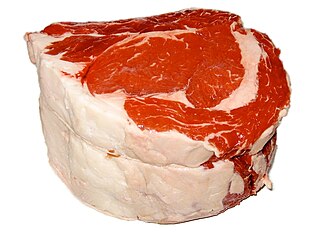 W
WBeef is the culinary name for meat from cattle.
 W
WNational Cattlemen's Beef Association (NCBA) is an American trade association and lobbying group working for the American beef producers and consumers in the United States.
 W
WThe 2008 US beef protest in South Korea was a series of protest demonstrations made between 24 May 2008 and mid August 2008. against president Lee Myung-bak in Seoul, Korea. The protest involved several hundred thousands and at its height up to one million people. The protest began after the South Korean government reversed a ban on US beef imports. The ban had been in place since December 2003, when mad cow disease was detected in US beef cattle.
 W
WArby's is an American fast food sandwich restaurant chain with more than 3,300 restaurants system wide and third in terms of revenue. In October 2017, Food & Wine called Arby's "America's second largest sandwich chain ".
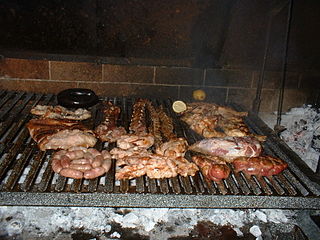 W
WBeef is a key component of traditional Argentine cuisine.
 W
WBeef aging or ageing is a process of preparing beef for consumption by aging it, in order to break down the connective tissue within the meat.
 W
WThe Beef Bones Regulations 1997 were a statutory instrument of the British government that limited the sale of beef on the bone. The regulations were implemented as a response to the United Kingdom BSE outbreak over fears that variant Creutzfeldt–Jakob disease in humans might be caused by the consumption of dorsal root ganglia, which lie near the bone. As well as beef on the bone, all beef-bone derived products were prohibited from sale. This had the effect of outlawing T-bone steaks, prime ribs and oxtail as well as some soups and stocks. Other aspects of the regulations dealt with the deboning of beef and the keeping of records in the food production industry. The restrictions on sales were lifted in December 1999 and the regulations as a whole were revoked in April 2008.
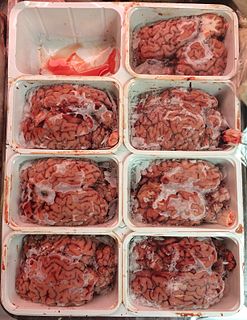 W
WBeef brains and veal or calf's brains are used in the cuisines of France; Italy; Spain; El Salvador; Mexico, etc. where they are called sesos in Spanish and are eaten in tacos and quesadillas; Pakistan and Bangladesh, where they are known in Urdu and Bengali as Maghaz; Portugal; Indonesia; and in the United States, especially in St. Louis, Missouri, and the Ohio River valley.
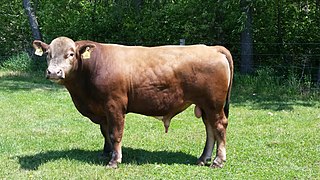 W
WBeefalo constitute a fertile hybrid offspring of domestic cattle, usually a male in managed breeding programs, and the American bison, usually a female in managed breeding programs. The breed was created to combine the characteristics of both animals for beef production.
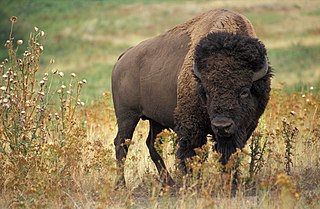 W
WThe American bison or simply bison, also commonly known as the American buffalo or simply buffalo, is an American species of bison that once roamed North America in vast herds. Its historical range, by 9000 BC, is described as the great bison belt, a tract of rich grassland that ran from Alaska to the Gulf of Mexico, east to the Atlantic Seaboard as far north as New York and south to Georgia and, according to some sources, further south to Florida, with sightings in North Carolina near Buffalo Ford on the Catawba River as late as 1750. It nearly became extinct by a combination of commercial hunting and slaughter in the 19th century and introduction of bovine diseases from domestic cattle. With a population in excess of 60 million in the late 18th century, the species was down to just 541 animals by 1889. Recovery efforts expanded in the mid-20th century, with a resurgence to roughly 31,000 wild bison today, largely restricted to a few national parks and reserves. Through multiple reintroductions, the species is now also freely roaming wild in some regions in the United States, Canada, and Mexico, with it also being introduced to Yakutia in Russia.
 W
WBresaola is air-dried, salted beef that has been aged two or three months until it becomes hard and turns a dark red, almost purple color. It is made from top (inside) round, and it is lean and tender, with a sweet, musty smell. It originated in Valtellina, a valley in the Alps of northern Italy's Lombardy region.
 W
WBrisket is a popular dish of braised beef brisket in Ashkenazic Jewish cuisine.
 W
WBully beef is a variety of meat made from finely minced corned beef in a small amount of gelatin. The name "bully beef" likely comes from the French "bouilli" (boiled) in Napoleonic times, or possibly from the head of a bull depicted on the popular Hereford brand of canned corned beef. The cans have a distinctive oblong shape. Bully beef and hardtack biscuits were the main field rations of the British Army from the Boer War to World War II. It is commonly served sliced in a corned beef sandwich. Potato-based dishes, such as "Hash and hotch-potch", in which the potatoes and beef are stewed together, and "Corned Beef Hash", where pre-boiled potatoes and corned beef are mixed with Worcestershire sauce then fried, are also made. Tinned corned beef is also used in France. Some places where British troops had a heavy presence in the 20th century, such as Malta, have adopted bully beef as part of their national cuisine. In February 2009, the British Defence Equipment and Support announced that they would be phasing out bully beef from ration packs as part of the introduction of the new Multi-Climate Ration Packs until this change was reversed due to backlash.
 W
WIn Mexican cuisine, cabeza is the meat from a roasted head of an animal, served as taco or burrito fillings.
 W
WCorned beef, or salt beef in the British Commonwealth of Nations, is salt-cured brisket of beef. The term comes from the treatment of the meat with large-grained rock salt, also called "corns" of salt. Sometimes, sugar and spices are added to corned beef recipes. Corned beef is featured as an ingredient in many cuisines.
 W
WCow lung is used in various cuisines and as a source for pulmonary surfactants. In Peru it is known as bofe. In Indonesia, Nasi kuning can be made with cow lung. Paru goreng is fried cow lung Padang food. It is a type of offal.
 W
WFrankfurter Rindswurst is a sausage made of beef. It was introduced in 1894 by Frankfurt butcher Gref-Volsing to meet the demands of the growing Jewish population of the city and has since become one of its most famous delicacies. The sausage may be boiled, broiled, or grilled. The best-known manufacturer is the Frankfurt company Gref-Völsing.
 W
WKobe beef is Wagyu beef from the Tajima strain of Japanese Black cattle, raised in Japan's Hyōgo Prefecture according to rules set out by the Kobe Beef Marketing and Distribution Promotion Association. The meat is a delicacy, valued for its flavor, tenderness, and fatty, well-marbled texture. Kobe beef can be prepared as steak, sukiyaki, shabu-shabu, sashimi, and teppanyaki. Kobe beef is generally considered one of the three top brands, along with Matsusaka beef and Ōmi beef or Yonezawa beef.
 W
WMogodu is a Southern African food. Mogodu is a combination of chopped serobe (tripe) and mala (intestines) served as a stew often with hot pap or dumpling. Mala is intestines, usually of a mammal such as a cow or sheep.
 W
WMatsusaka beef is the meat of Japanese Black cattle reared under strict conditions in the Matsusaka region of Mie in Japan. It has a high fat-to-meat ratio. Within Japan, it is one of the three Sandai Wagyū, the "three big beefs"; the others are Kobe beef and Ōmi beef or Yonezawa beef. About 2500 cows are slaughtered for Matsusaka beef each year; the meat commands high prices.
 W
WAt the 2010 MTV Video Music Awards, American singer Lady Gaga wore a dress made of raw beef, which was commonly referred to by the media as the meat dress. Designed by Franc Fernandez and styled by Nicola Formichetti, the dress was condemned by animal rights groups, and named by Time magazine as the top fashion statement of 2010.
 W
WMeat extract is highly concentrated meat stock, usually made from beef. It is used to add meat flavour in cooking, and to make broth for soups and other liquid-based foods.
 W
WPastrami is a Romanian variant of the Turkish pastırma usually made from beef brisket, and sometimes from lamb, or turkey. The raw meat is brined, partially dried, seasoned with herbs and spices, then smoked and steamed. Like corned beef, pastrami was originally created as a way to preserve meat before the invention of refrigeration. One of the iconic meats of American Jewish cuisine and New York City cuisine, hot pastrami is typically served at delicatessens on sandwiches such as the pastrami on rye.
 W
WA paupiette is a piece of meat, beaten thin, and rolled with a stuffing of vegetables, fruits or sweetmeats. It is often featured in recipes from Normandy. It is often fried or braised, or baked in wine or stock. They are very popular in France, being sold ready-prepared in supermarkets and butchers. Paupiettes can be made with various items such as chicken, beef, lamb, fish, veal, cabbage, turkey escalopes or slices of calves' sweetbreads.
 W
WPink slime is a meat by-product used as a food additive to ground beef and beef-based processed meats, as a filler, or to reduce the overall fat content of ground beef. As part of the production process, heat and centrifuges remove the fat from the meat in beef trimmings. The resulting paste, without the fat, is exposed to ammonia gas or citric acid to kill bacteria. In 2001, the United States Department of Agriculture (USDA) approved the product for limited human consumption. The product, when prepared using ammonia gas, is banned for human consumption in the European Union.
 W
WRax Roast Beef is a regional U.S. fast food restaurant chain specializing in roast beef sandwiches. The company is based in Ironton, Ohio. Once a major player in the fast food industry, Rax has extensively scaled down its operations since its peak in the 1980s.
 W
WRoast beef is a traditional dish of beef that is roasted. Essentially prepared as a main meal, the leftovers are often used in sandwiches and sometimes are used to make hash. In the United Kingdom, United States, Canada, Ireland, South Africa, New Zealand, and Australia, roast beef is one of the meats traditionally served at Sunday lunch or dinner, although it is also often served as a cold cut in delicatessen stores, usually in sandwiches. A traditional side dish to roast beef is Yorkshire pudding.
 W
WSagol, or beef leg bone, is an ingredient in Korean cuisine. Sagol is often boiled to make a broth, called sagol-yuksu, or beef leg bone broth, for Korean soups such as gomguk, galbi-tang, tteokguk, kal-guksu, or gukbap.
 W
WA steak is a meat generally sliced across the muscle fibers, potentially including a bone. It is normally grilled, though can also be pan-fried. Steak can also be cooked in sauce, such as in steak and kidney pie, or minced and formed into patties, such as hamburgers.
 W
WTripas, in Mexican cuisine, are the small intestines of farm animals that have been cleaned, boiled and grilled. Tripas are used as filling for tacos, and then dressed with condiments such as cilantro, chopped onions, and chile sauce. They are also served with pico de gallo and guacamole.
 W
WThe United Kingdom was afflicted with an outbreak of Bovine spongiform encephalopathy, and its human equivalent variant Creutzfeldt–Jakob disease (vCJD), in the 1980s and 1990s. Over four million head of cattle were slaughtered in an effort to contain the outbreak, and 177 people died after contracting vCJD through eating infected beef. A political and public health crisis resulted, and British beef was banned from export to numerous countries around the world, with some bans remaining in place until as late as 2019.
 W
WVeal is the meat of calves, in contrast to the beef from older cattle. Veal can be produced from a calf of either sex and any breed, however most veal comes from young male calves of dairy breeds which are not used for breeding. Generally, veal is more expensive per pound than beef from older cattle. Veal production is a way to add value to dairy bull calves and to utilize whey solids, a byproduct from the manufacturing of cheese.
 W
WThe water buffalo, also called the Asiatic buffalo, domestic water buffalo or Asian water buffalo, is a large bovid originating in the Indian subcontinent and Southeast Asia. Today, it is also found in Europe, Australia, North America, South America and some African countries. Two extant types of water buffalo are recognized, based on morphological and behavioural criteria: the river buffalo of the Indian subcontinent and further west to the Balkans, Egypt and Italy and the swamp buffalo, found from Assam in the west through Southeast Asia to the Yangtze valley of China in the east.
 W
WŻubroń is a hybrid of domestic cattle and wisent. The wisent is the European bison; hence, the żubroń is analogous to the American beefalo. The name żubroń was officially chosen from hundreds of proposals sent to the Polish weekly magazine Przekrój during a contest organised in 1969.